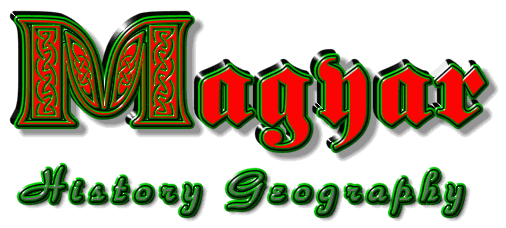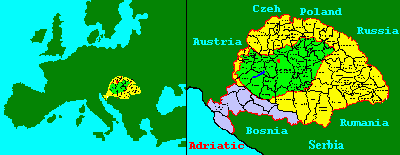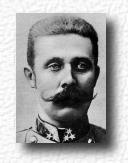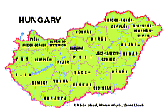![]()

![]()
Home | Before 1700 A.D. | After 1700 A.D.
 The map below shows landlocked,
modern Hungary (light green area) and its position on the
European continent. Hungary was a much larger place in the past,
she even had access to the Adriatic Sea at one time via the
nation state of Croatia (grey area on map above) - a
separate land of the Hungarian Crown. The Hungarian king Kálmán I. (1095-1116), took possession of the
former kingdom of Croatia in 1097, of which he was crowned king
in 1106. This was a dynastic acquisition not one of force.
Croatia was never treated as an integral part of Hungary. The
royal title ran 'King of Hungary and Croatia' and Croatia was
administered by a viceroy ('Ban') through its own institutions. [Macartney] Modern Hungary together with the
large yellow and grey areas made up the kingdom of Hungary before
1920. Click on the map for a much larger view of the historical
counties of Hungary.
The map below shows landlocked,
modern Hungary (light green area) and its position on the
European continent. Hungary was a much larger place in the past,
she even had access to the Adriatic Sea at one time via the
nation state of Croatia (grey area on map above) - a
separate land of the Hungarian Crown. The Hungarian king Kálmán I. (1095-1116), took possession of the
former kingdom of Croatia in 1097, of which he was crowned king
in 1106. This was a dynastic acquisition not one of force.
Croatia was never treated as an integral part of Hungary. The
royal title ran 'King of Hungary and Croatia' and Croatia was
administered by a viceroy ('Ban') through its own institutions. [Macartney] Modern Hungary together with the
large yellow and grey areas made up the kingdom of Hungary before
1920. Click on the map for a much larger view of the historical
counties of Hungary.
Genealogy is meaningless without an appreciation and understanding of the history and the forces which shaped the lives of our ancestors. Hungarian history is just as rich and interesting as that of France, England and so on. For example, Hungary has been called the "Shield of Christianity" for her role in bearing most of the destructive forces thrown at Europe during the Mongol invasions in 1241-2 followed by the Turkish threat in the 15th. and 16th. Centuries. Hungary's successes against the Turks under Lajós Kossuth in the 15th. Century are still celebrated by the ringing of church bells at midday in Europe though the reason is probably long forgotten.
School courses and books on European Medieval History quite often refer to Hungary as some vague ethereal presence. English books tend to concentrate mainly on so-called Western Europe - England, Ireland, France, Germany and Italy and even Russia. Often Hungary's neighbours such as Serbia, Rumania, Slovakia, the Ukraine, Croatia, Bosnia get more coverage, but Hungary is curiously ignored by most writers. One can learn more about the smallest nations in East-Central Europe than about Hungary. This is most puzzling, it does not seem to be justified in view of Hungary's geographic position on the Continent and her great wealth in the Medieval period in which
1.Hungary produced two sainted kings, and thus had the pull with the papacy. No mean feat, to obtain papal favour just like France (England wasn't even close to having that kind of influence, as the Anglo-Saxon royal saints weren't canonized by the papacy).
2.The Hungarian monarchy was established by papal grant like that of the Carolingians.
3.A king of Hungary ruled the Holy Roman Empire; no French king after the Carolingians did, no English king did.
4.Hungary was at the centre of medieval European political marriages and pivotal to the alliance system.
5.The king of Hungary participated in crusade like the Holy Roman Emperor, the King of France, the King of England, etc.
6.Hungary experienced the same sort of baronial unrest as England in approximately the same time-frame with virtually the same results.
Even a cursory familiarity with the role of Hungary in medieval European history makes nonsense of the claim that Hungary wasn't part of the medieval West. The fact that many ... are fascinated with England and France leads them often to forget that the centre of medieval Western Europe was the Rhine, not the English Channel. If Hungary is peripheral to medieval Western Europe, England is just as peripheral and Ireland is like the Ukraine. [Rose]
Hungary's greatest period had passed with the coming of the Turks in the 16th. century, who, in turn, remember that period as their greatest. The Turkish Empire had been the largest in their history with the defeat of Hungary. Between a rock and a hard place; the Hapsburgs in the West and the incessant attacks from the East, Hungary was perhaps always doomed. Her fate had been determined from the day the Hapsburg Empire had taken possession of her territories in 1699. Hapsburg rule marked the beginnings of the conflict of languages and nationalities and of the struggle for equality within the framework of historic Hungary. In other words it represented the break between modern Hungary and king St. Stephen's medieval Hungary.
The ethnic conflicts in historic Hungary had been engineered and nurtured by the Hapsburgs with their haphazard process of colonization and by their policy of divide and rule in order to keep the various ethnic groups off balance and in continual conflict. Hungary's 'minorities', as Hungarian citizens, had rightly clamored for a greater say but they were not conquered peoples, in stark contrast to Russia, Germany, Britain, Italy and even France who had millions of colonial subjects in Asia, Africa and the Balkans. It was a time of separatist nationalist movements manipulated by the major and minor powers whose only aim was to break up and annex large parts of Austria-Hungary. The times were marked by hypocrisy, dishonour and double-standards; Hungary in 1920 was simply a victim of RčalPolitik.
Though there are older historical factors involved, it was surprising to conclude that much of the continuing trouble in Eastern Europe and the Balkans can be attributed to French interference in the region's affairs in 1918-20. The great tragedy is that, instead of building a more stable East-Central Europe, the French had deliberately dismantled and partitioned it. France, as the major European player, could have become the regenerator and a great leader of Europe, but the French had missed that once-in-a-millenium opportunity amid an orgy of revenge and retribution, not entirely as a result of WWI but stemming from the deep humiliation they had suffered in losing German speaking Alsace-Lorraine in 1871 - these areas had been subjects of dispute for over three hundred years!
 When Austria was driven to declare
war on Serbia in 1914 by the assassination of the Austrian
Archduke Franz Ferdinand, Hungary was bound by treaty and by her
obligations to support her Austrian ally. Hungary had no
territorial ambitions at that time, and had everything to lose
and nothing to gain. As punishment, Austria had deservedly lost her conquered
Slavic lands and virtually none of her Germanic homeland. Hungarians, on the other hand, had lost 71.5%
of their homeland in 1920, most of which had been settled over
1100 years earlier by their ancestors.
When Austria was driven to declare
war on Serbia in 1914 by the assassination of the Austrian
Archduke Franz Ferdinand, Hungary was bound by treaty and by her
obligations to support her Austrian ally. Hungary had no
territorial ambitions at that time, and had everything to lose
and nothing to gain. As punishment, Austria had deservedly lost her conquered
Slavic lands and virtually none of her Germanic homeland. Hungarians, on the other hand, had lost 71.5%
of their homeland in 1920, most of which had been settled over
1100 years earlier by their ancestors.
No matter how much one wishes it, revising the geographic borders of Central Europe created in the early decades of the twentieth century cannot but cause greater distress in the region. However, that does not justify forgetting and ignoring Hungary and her people (Magyar AND non-Magyar) of 1920, who were subjected to the most degrading and dishonourable example of predation committed with French approval and outmatched in savagery only by the two partitions of Polish territory in the 18th. century by Russia, Prussia and Austria.
All this is now history, but the suffering in the new Alsace-Lorraines is not.
This document is structured as follows:-
| (1). One View - The Sumerian
Connection (2). Indogermanic View - The Finno-Ugrian Theory |
The year 1700 A.D. was chosen as it marks the expulsion of the Turks from Hungary by the Hapsburgs and out of the need to keep web pages as small as possible.
Home | Before 1700 A.D. | After 1700 A.D.
Hungary was and is divided into counties much like any other country. Once these counties had the status of the "vármegye" or castle or fortress county. Around 1876 there were 64 such castle counties making up the kingdom. See the Historical Text Archives for a view of the colourful and sometimes bloody coats of arms of the original counties.
This site http://lazarus.elte.hu/hun/maps/1910/ has maps from 1910 of the original Hungarian counties. The maps are very large and take a long time to load but well worth it.
 Modern Hungary consists of 19
counties. See the settlements of modern
Hungary at this site http://testver.sednet.hu/e_homepage.html
Modern Hungary consists of 19
counties. See the settlements of modern
Hungary at this site http://testver.sednet.hu/e_homepage.html
For genealogical research it is important to realise that some of the modern counties are conglomerations of what was left over from the great land grab of 1920.
For example, the modern county of "Borsod-Abaúj-Zemplén" is made up of the remains of the original counties of Borsod, Abaúj-Torna and Zemplén (a large part of the last two counties was taken by Slovakia). While "Szabolcs-Szatmár-Bereg" was part of Szabolcs, Szatmár and Bereg counties most of which was taken by Rumania and Russia (now the Ukraine). "Hajdú-Bihar" was part of Hajdú and Bihar counties (most of the latter now lies in Rumania). "Komarom-Esztergom" was made up out of the remains of Komarom and Esztergom counties (half of each was taken by Slovakia). "Győr-Moson-Sopron" was once part of the counties Győr, Moson and Sopron (parts of the last two counties went to Austria).
If any genealogical researcher is looking for Csanád county then note that it was absorbed into Csongrád and possibly into Békés county also at some time.
Home | Before 1700 A.D. | After 1700 A.D.
![]()
Last updated 27 March 1999
Maintainer T. Majlath
![]()